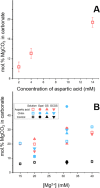Organic Controls over Biomineral Ca-Mg Carbonate Compositions and Morphologies
- PMID: 37426546
- PMCID: PMC10326858
- DOI: 10.1021/acs.cgd.3c00102
Organic Controls over Biomineral Ca-Mg Carbonate Compositions and Morphologies
Abstract
Calcium carbonate minerals, such as aragonite and calcite, are widespread in biomineral skeletons, shells, exoskeletons, and more. With rapidly increasing pCO2 levels linked to anthropogenic climate change, carbonate minerals face the threat of dissolution, especially in an acidifying ocean. Given the right conditions, Ca-Mg carbonates (especially disordered dolomite and dolomite) are alternative minerals for organisms to utilize, with the added benefit of being harder and more resistant to dissolution. Ca-Mg carbonate also holds greater potential for carbon sequestration due to both Ca and Mg cations being available to bond with the carbonate group (CO32-). However, Mg-bearing carbonates are relatively rare biominerals because the high kinetic energy barrier for the dehydration of the Mg2+-water complex severely restricts Mg incorporation in carbonates at Earth surface conditions. This work presents the first overview of the effects of the physiochemical properties of amino acids and chitins on the mineralogy, composition, and morphology of Ca-Mg carbonates in solutions and on solid surfaces. We discovered that acidic, negatively charged, hydrophilic amino acids (aspartic and glutamic) and chitins could induce the precipitation of high-magnesium calcite (HMC) and disordered dolomite in solution and on solid surfaces with these adsorbed biosubstrates via in vitro experiments. Thus, we expect that acidic amino acids and chitins are among the controlling factors in biomineralization used in different combinations to control the mineral phases, compositions, and morphologies of Ca-Mg carbonate biomineral crystals.
© 2023 The Authors and Smithsonian Institution. Published by American Chemical Society.
Conflict of interest statement
The authors declare no competing financial interest.
Figures







Similar articles
-
Low-Temperature Synthesis of Disordered Dolomite and High-Magnesium Calcite in Ethanol-Water Solutions: The Solvation Effect and Implications.ACS Omega. 2021 Dec 17;7(1):281-292. doi: 10.1021/acsomega.1c04624. eCollection 2022 Jan 11. ACS Omega. 2021. PMID: 35036699 Free PMC article.
-
Studies of biominerals relevant to the search for life on Mars.Orig Life Evol Biosph. 2006 Dec;36(5-6):621-2. doi: 10.1007/s11084-006-9045-2. Orig Life Evol Biosph. 2006. PMID: 17120120
-
High Magnesium Calcite and Dolomite composition carbonate in Amphiroa (Lithophyllaceae, Corallinales, Rhodophyta): further documentation of elevated Mg in Corallinales with climate change implications.J Phycol. 2021 Apr;57(2):496-509. doi: 10.1111/jpy.13098. Epub 2020 Dec 26. J Phycol. 2021. PMID: 33155284
-
Structure and composition of calcareous sponge spicules: a review and comparison to structurally related biominerals.Micron. 2008;39(3):209-28. doi: 10.1016/j.micron.2007.01.006. Epub 2007 Feb 3. Micron. 2008. PMID: 17360189 Review.
-
The impact of environmental acidification on the microstructure and mechanical integrity of marine invertebrate skeletons.Conserv Physiol. 2019 Nov 11;7(1):coz062. doi: 10.1093/conphys/coz062. eCollection 2019. Conserv Physiol. 2019. PMID: 31737270 Free PMC article. Review.
Cited by
-
Post-mortem recrystallization of biogenic amorphous calcium carbonate guided by the inherited macromolecular framework.Sci Rep. 2024 Jul 27;14(1):17304. doi: 10.1038/s41598-024-68037-y. Sci Rep. 2024. PMID: 39068177 Free PMC article.
References
-
- Knoll A. H. Biomineralization and Evolutionary History. Rev. Mineral. Geochem. 2003, 54, 329–356. 10.2113/0540329. - DOI
-
- Langer G.; Geisen M.; Baumann K. H.; Kläs J.; Riebesell U.; Thoms S.; Young J. R. Species-Specific Responses of Calcifying Algae to Changing Seawater Carbonate Chemistry. Geochem., Geophys. Geosystems 2006, 7, 0122710.1029/2005GC001227. - DOI
-
- Schiebel R. Planktic Foraminiferal Sedimentation and the Marine Calcite Budget. Global Biogeochem. Cycles 2002, 16, 3-1–3-21. 10.1029/2001gb001459. - DOI
LinkOut - more resources
Full Text Sources
